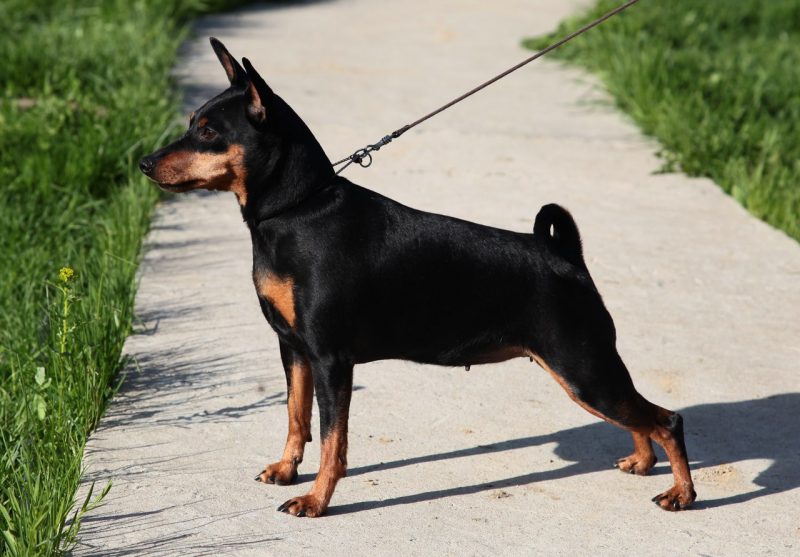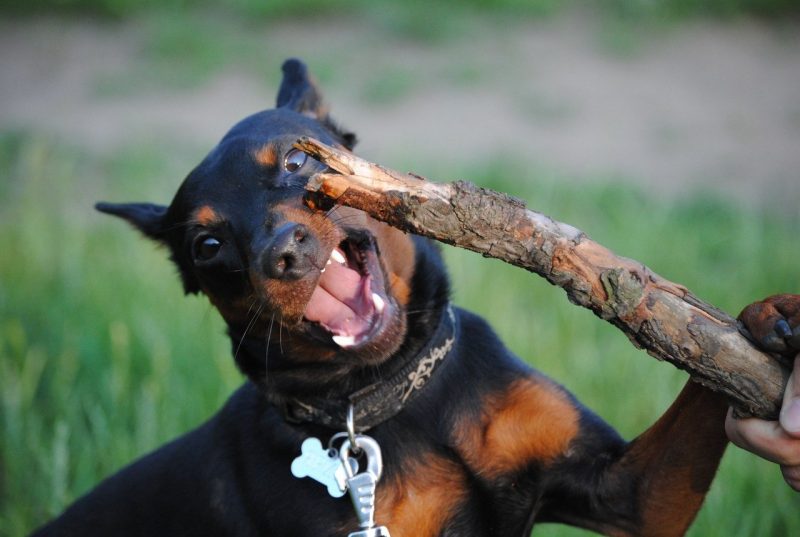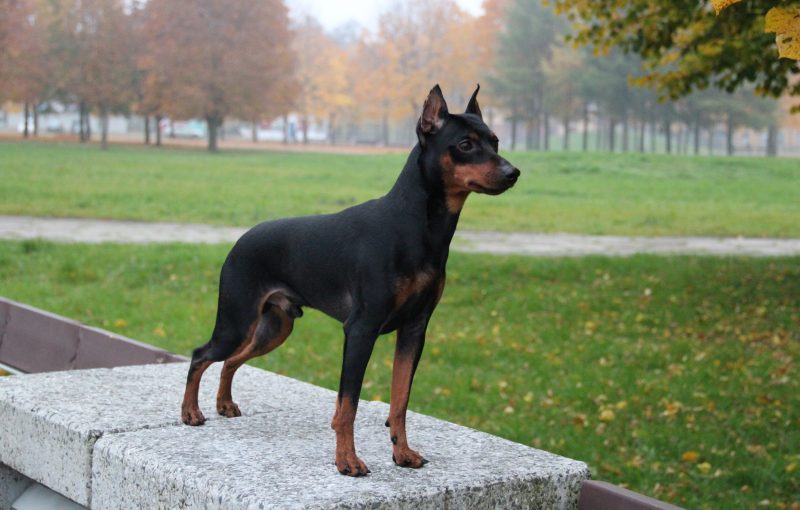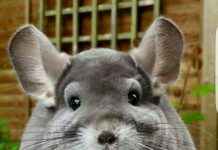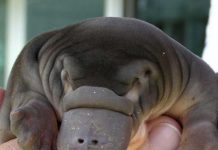Many people think that the dwarf pincher is a Doberman in a reduced form. Experts say that this is a false statement. What you need to know about the standards of the dog, how to properly educate and care for it, let's talk in today's article.
Material Content:
Origin history
The dwarf pincher dog first appeared in Germany. The first mention of the pet dates back to the XV century. According to scientists, the "mini-Dobermans" were bred in the Kingdom of Württemberg. Dogs lived on farms and guarded cattle from rats and other small rodents. Later they began to take with them on a hunt. A loud barking of a dog scared away large animals along the way.
Dwarf pinschers (miniature pinschers) remained in the shadows for a long time, despite their centuries-old history. Only in 1878 this breed of dogs was demonstrated to the general public at the exhibition. After that, breeders seriously engaged in the cultivation of dwarf pinschers. Their main task was to achieve a smaller animal.
In 1880, a standard and description of the breed was introduced. Dogs were very popular with court ladies. They began to buy as pets.
In 1895, dogs were taken to an international exhibition, which was held in France. So the breed has spread around the world. She has not lost popularity today.
Description of the dwarf pincher
The miniature pinscher is a small dog. Males are slightly larger than bitches. Height at the withers reaches a maximum of 30 cm. If more, this is not the standard. Weight is also small, on average 4-5 kg. It is worth noting that these dogs are the smallest among the representatives of the pinschers.
The peculiarity of the animal is its short, smooth coat. The dog should not have bald spots. Otherwise, this indicates the presence of diseases. Wool does not require special care.
The color is brown or black. By standard, the animal should be monochrome. But often there are dwarf pinchers with small specks in the chest, paws, ears.
Life span
"Mini Doberman" lives on average 12-13 years.
The animal is exposed to the following diseases:
- Diabetes. As a rule, is inherited. If the animal has such a problem, bald patches on the coat and wounds will certainly appear.
- Urolithiasis disease. Mainly due to poor quality nutrition. It is better to feed dwarf pinschers with premium-class feeds, be sure to give ordinary foods with a high protein content.
- Eye diseases. Many animals of this breed in old age suffer from glaucoma, corneal dystrophy.
- Allergy. Wounds and sores appear on the body of the animal, the skin begins to peel off. This ailment, as a rule, develops due to improper or poor-quality nutrition. If such symptoms appear, you need to change the menu and diet of the pet.
Many dog breeders have seen from their own experience that if you love and properly care for the dwarf pinscher, the animal can live 15-16 years.
The purpose and nature of the dog
It is a mistake to assume that small breeds of dogs are not able to protect their owners. The dwarf pinscher is a fighter, an excellent watchman, he can be quite aggressive.
Character traits are as follows:
- Active and playful. Dwarf pinschers like to spend time on a walk. The best rest for them is a trip to the forest or swimming in the lake. If the owner does not have time to walk with the pet, it is better to choose a different breed.
- Easy to learn. Mini-Dobermans are easy to train. The animal is smart, remembers commands from 3-4 times. It is better to raise a dog from an early age, otherwise an adult will cease to obey.
- Loving. They give all their love to the owner. But they are disposed to strangers almost aggressively, they can bite.
Miniature pinsters get along with other pets with difficulty. The dog likes to take a leadership position, in order to achieve this, it can be aggressive.
The character of the dog helps her get along with the children. But if the pet is in a bad mood, it can scare the baby with a loud and sonorous barking. But offends children very rarely.
Dog breeders do not recommend having a dwarf pinscher puppy for those families with small children. Small animal, any inaccurate action on the part of the child can harm the pet.
The purpose of the dog is a loyal friend, companion. Dwarf pinschers will not sit in four walls. Ideal hosts for him are those who love outdoor activities, often travel through forests, lakes, and go to the mountains.
The animal is active, able to walk tens of kilometers. This allows him not to freeze, despite his short coat.
Breed standard and puppy selection
Dog breeders distinguish common features of the breed standard:
- The body is elongated, strong, taut.
- Paws The dwarf pincher is active, so the limbs are strong. The rear ones are slightly longer than the front ones.
- Head. The muzzle is a little elongated. The eyes are small, oval. Black or dark brown. The jaw is powerful.
- Neck. Long, strong.
- The ears. Tall, sticking out.
- Tail. Long, thin, erect.
- Color. The standard implies only a few shades: black and dark brown.
- Weight - 4-5 kg.
- Growth at the withers - 24-30 cm.
Many are still arguing about stopping the tail and ears of dwarf pinchers. By breed standards, this can be done. Such individuals are accepted to exhibitions without problems.
Animals tolerate surgery well, wounds heal quickly. The only moment: the ears stop until the dog is 4 months old and the tail is 1 week old.
When planning to purchase a puppy of a dwarf pinscher, you need to pay attention to the following points:
- The pet must be active, curious, playful.
- Take a look at the bitch. If the animal is well-groomed, well-fed, active, then the dwarf pincher puppies will be healthy.
- Check how the animal eats. Young dogs eat the proposed treat immediately.
- Be sure to check the bite. If it is wrong, the animal will often get sick.
- Mucous eyes, mouth should be clean.
- The coat is short, smooth and shiny.
- Unpleasant putrefactive odors should not come from the ears and mouth.
When buying, check the animal's passport and vaccination.
Puppies are best acquired at the age of 2-3 months. At this time, they are already ready for separation from their mother, independent. It is more difficult to cope with an adult animal. He has already developed his character and attachment to the previous owner.
Maintenance, care and feeding
"Miniature Doberman" needs care. First of all, he does not fit to live in a booth on the street. The hair of the animal is short, because of this heat transfer is insufficient.
In the autumn and winter, breeders recommend wearing special dog clothes on the dwarf pinscher. It should not hamper the mobility of the pet. Without fail, the animal’s breast and head are covered.
Dwarf pinschers suffer from urolithiasis, so the owners need to accustom the animal to the tray. If he suffers, waiting for walking, the disease can not be avoided.
The disease is acute in the animal, in most cases it is necessary to put a catheter. The operation is performed under general anesthesia, which negatively affects the heart of the pet. Therefore, it is better not to bring to such a situation.
The dwarf pincher does not tolerate loneliness. Being alone in the apartment, the pet will begin to bite and scratch the furniture. To prevent this from happening, the puppy should have a favorite toy on which he will vent anger (gnaw, bite, tear).
In general, care for a dwarf pincher boils down to the following:
- Rubbing wool after walking with a wet sponge. It is enough to bathe an animal 3-4 times a year so as not to disturb the acid-base balance of the skin. Otherwise, the dog may develop skin diseases.
- The hair needs to be combed out 2-3 times a week.
- Cut the claws in time.
- Keep your ears clean.
- Treat the oral cavity with special dog accessories.
You need to feed the dwarf pincher with mixed food: ordinary food and premium class food.
Feeding should take place 3 times a day.
The menu contains:
- Protein food. These are low-fat meats, boneless fish, cottage cheese, kefir.
- Porridge. They have a lot of fiber. Buckwheat and oatmeal are ideal.
- Vegetables. Can be given raw or boiled.
Sweets for the dog are strictly prohibited, they can provoke the development of diabetes.
Training "mini-Doberman"
The miniature pinscher lends itself well to training. The animal has a complex nature, so from an early age the pet needs to show who is in charge of the house.
You can do the training yourself. The dwarf pinscher quickly grabs and repeats the basic commands. You can’t beat a pet, it will show aggression, just raise your voice.
Advantages and disadvantages of the breed
The breed has its advantages and disadvantages.
The advantages are as follows:
- dogs are smooth-haired, do not fade;
- pinscher can easily protect the owner;
- the dog is beautiful, neat;
- the animal is smart, quickly amenable to training.
Minuses:
- a dwarf pinscher cannot live outside in a booth;
- the dog needs training, otherwise it becomes uncontrollable;
- the animal suffers from a number of chronic diseases, including urolithiasis;
- the pincher cannot stand loneliness.
The dwarf pincher belongs to the "miniature" dog breeds. Despite its small size, the animal can stand up for itself. If you need to protect the owner, immediately rushes into battle.
The dog requires special care. It is important for the owners to often walk with the pet in the fresh air.And also monitor his nutrition. Poor feed can cause urolithiasis in a dog.


